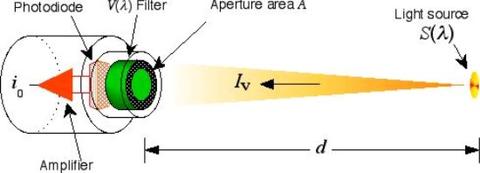Realization of the candela
The relative spectral responsivity of the human visual system was first defined by the Commission Internationale de l'Éclairage (CIE, the International Commission on Illumination) in 1924. It is called the spectral luminous efficiency function for photopic vision, given the symbol V(λ) and is defined in the wavelength domain from 360 nm to 830 nm, and normalized to unity at its peak, 555 nm. Because the characteristics of human vision are essential in photometry, the CIE republished these values in 1983. That same year the Comité International des Poids et Mesures (CIPM, the International Committee on Weights and Measures) adopted the CIE's values to supplement the 1979 definition of the candela.
The tabulated values of V(λ) are available in CIE references at 1 nm increments. These photometric values can be related to the radiometric quantity Xe,l(λ) through the definition of Xv, as specified in the definition of the candela in 1979 and a supplemental document from CIPM in 1983.

The constant, Km, relates the photometric quantities and radiometric quantities, and is called the maximum spectral luminous efficacy of radiation for photopic vision. The value of Km is 683 lm/W at 540 × 1012 Hz (555.016 nm in standard air). This frequency corresponds to the same frequency stated in the definition of spectral luminous efficacy given in the 1979 definition of candela. Note that while this is not exactly at the peak of V(λ) at 555 nm, the value of Km at 555 nm, 683.002 lm/W, is normally rounded to 683 lm/W with negligible error for all practical applications.
Detector-based realization of the candela
The candela is the unit of luminous intensity, and quantifies the intensity of a light source as observed by the human visual system. The Optical Technology Division at NIST is responsible for the realization of this SI base unit. It is realized using a detector-based method, which is directly traceable to the Division's Reference Cryogenic Radiometer, the Primary Optical Watt Radiometer (POWR), and is maintained on a set of well-characterized filtered detectors, the NIST standard photometers.
These standard photometers are constructed to emulate the CIE spectral luminous efficiency function for photopic vision, consisting of a silicon photodiode, a V(λ)-correction filter, and a precision aperture.

The unit, candela, is established from luminous intensity Iv of a source. For a light source measured with a photometer at a distance d, the luminous intensity is given, according to the inverse square law, by
where y is the output current of the photometer and Ω0 is the unit solid angle (equal to one steradian). The illuminance responsivity sv (in A/lx) of the photometer is determined by

where A is the area of the aperature, calibrated using a dimension-measuring instrument, V(λ) is the spectral luminous efficiency function, and Km is the maximum spectral luminous efficacy (683 lm/W). S(λ) is the relative spectral power distribution of the source, usually provided by Planckian radiation at 2856 K (CIE Standard Illuminant A). And, the absolute spectral power responsivity s(λ) (in A/W) of the entire photometer (as an average over the aperature area) is determined by calibration against the spectral responsivity scale based on the Primary Optical Watt Radiometer (POWR).
The uncertainty in determining the candela value at NIST is currently 0.4 % (k = 2). Other photometric units can then be derived using this base unit.
Contacts
-
(301) 975-2332

